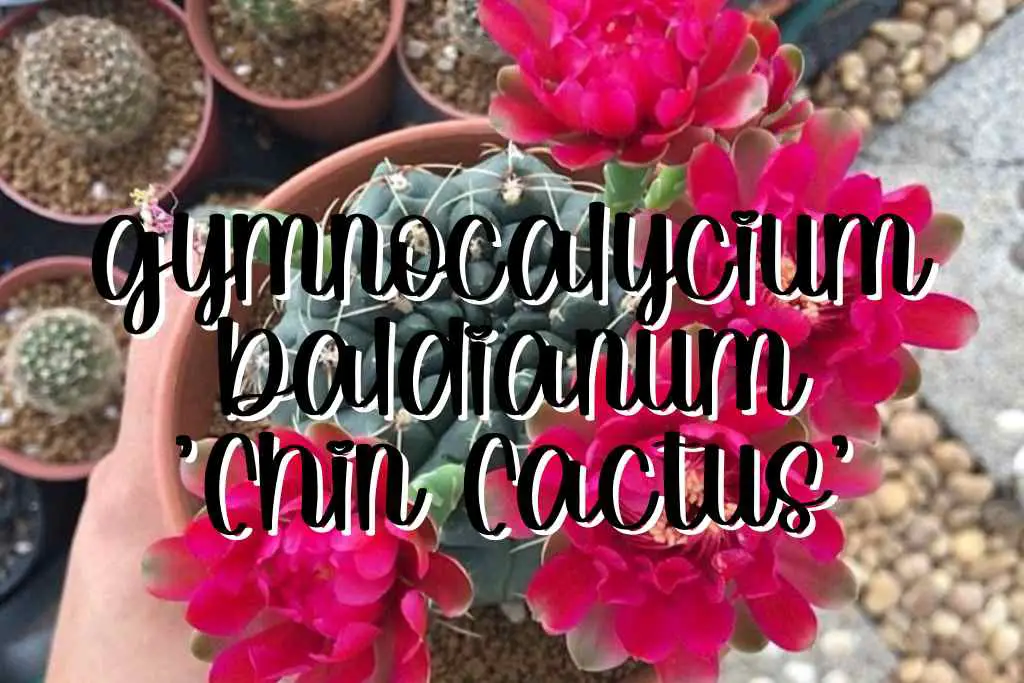Cacti enthusiasts, have you ever encountered a Gymnocalycium baldianum, also known as the Chin Cactus? If you’re new to the world of succulents or facing challenges in keeping your Chin Cactus happy, this comprehensive guide is just what you need. Let’s dive into the fascinating world of Gymnocalycium baldianum care and learn how to grow a thriving, beautiful cactus.
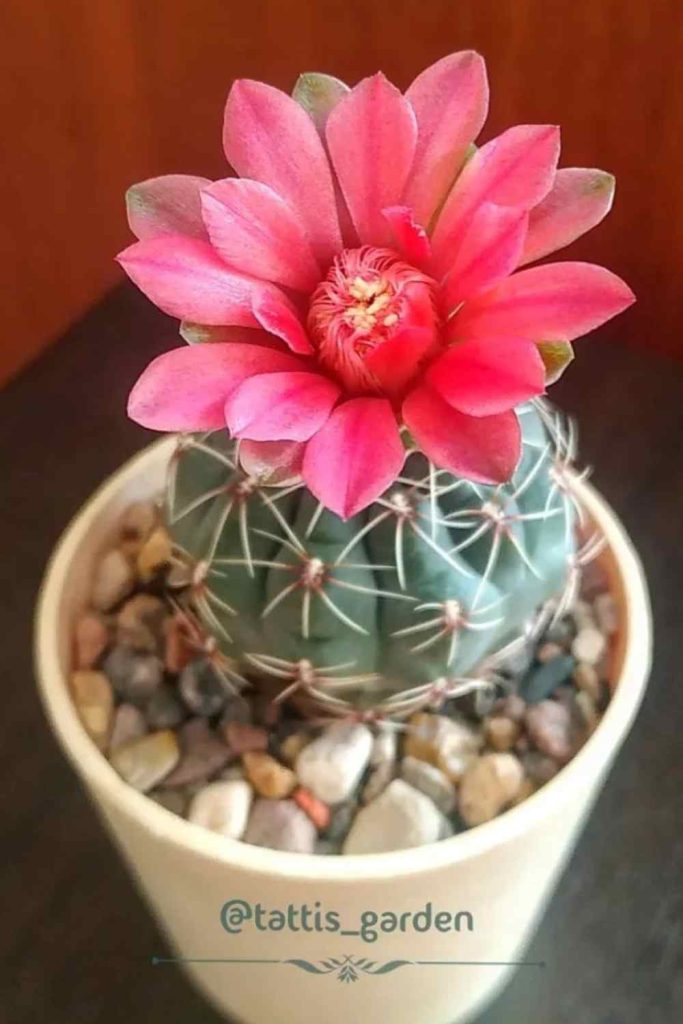
Dig in!
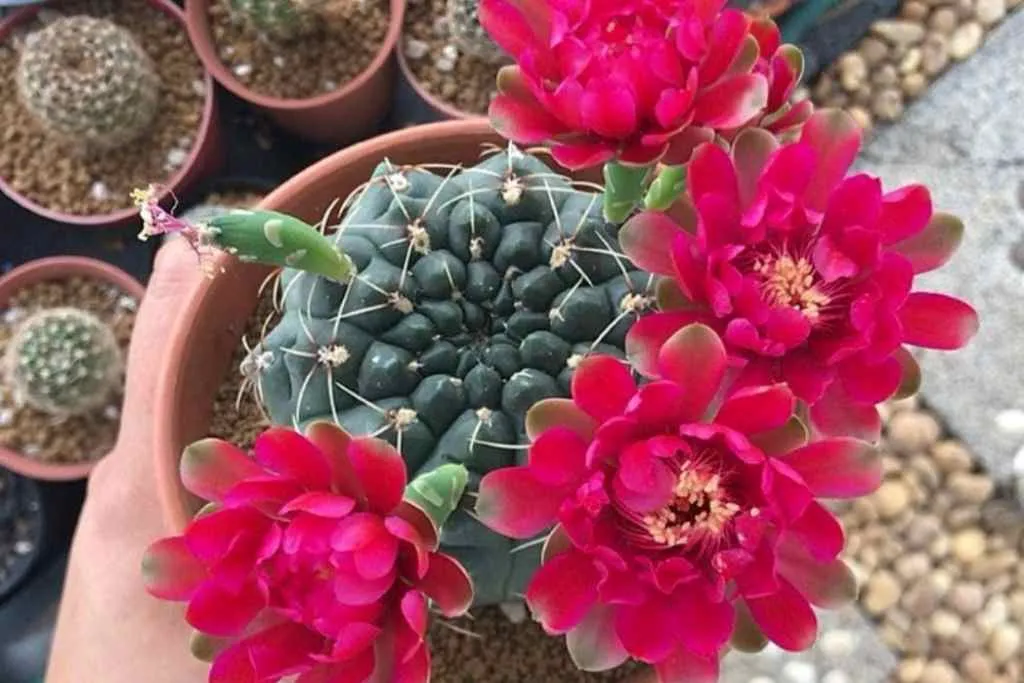
Gymnocalycium baldianum: A Quick Overview
Common Names
The Gymnocalycium baldianum is popularly known as the Chin Cactus or the Dwarf Chin Cactus, thanks to its small size and distinct appearance.
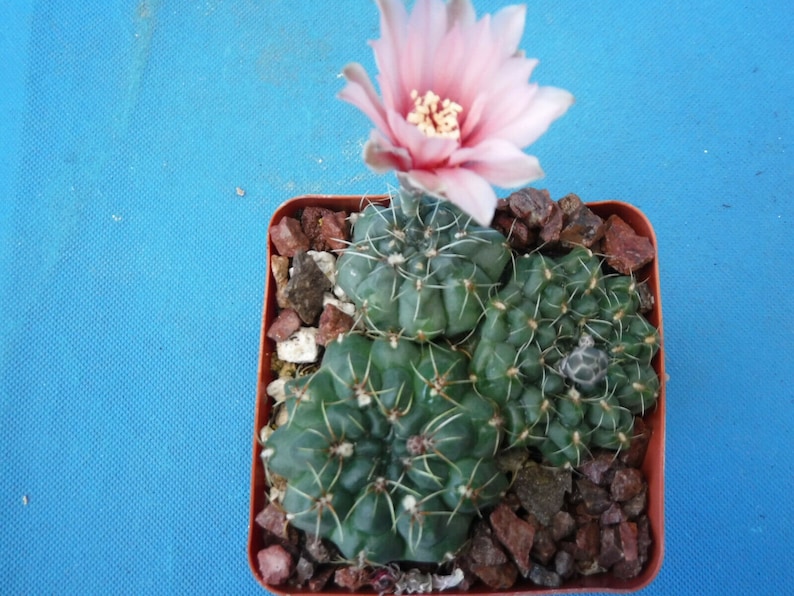
Source: Etsy
Appearance
Gymnocalycium baldianum ‘Chin Cactus’ is a small, globular cactus with a green to bluish-green body and thick, curved spines. It’s famous for its vibrant, funnel-shaped flowers that come in a variety of colors, including red, pink, and white.

Source: Etsy
Size and Growth Rate
Typically, a Gymnocalycium baldianum ‘Chin Cactus’ grows to a height of 2-4 inches and a diameter of 3-6 inches. The growth rate is relatively slow, so don’t be alarmed if your cactus takes its time to reach its full size.
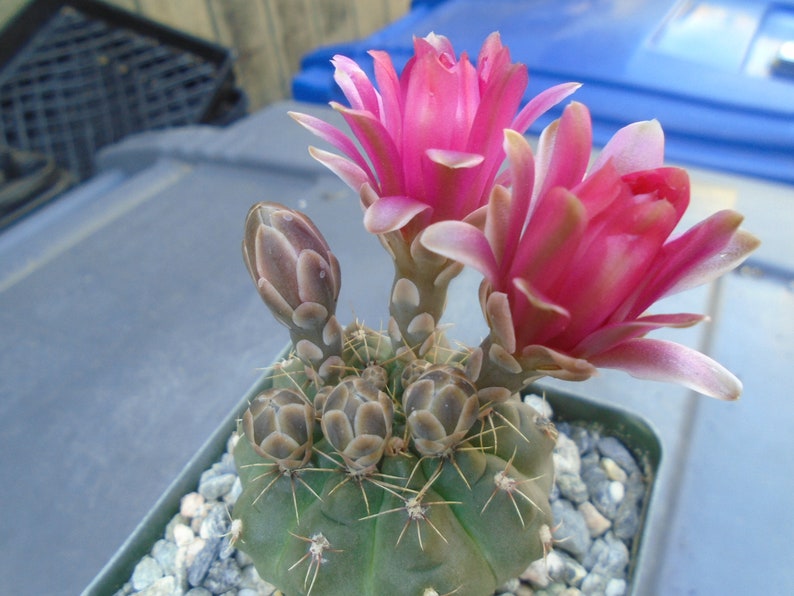
Source: Etsy
Proper Care for Your Chin Cactus
Watering
To keep your Gymnocalycium baldianum ‘Chin Cactus’ happy, water it sparingly. Allow the soil to dry out completely between waterings. Over-watering can lead to root rot, a common problem for succulents.
You might also like: How to Tell If Your Cactus Needs Water: A Comprehensive Care Guide

Source: Etsy
Fertilizing
Feed your Gymnocalycium baldianum ‘Chin Cactus’ a balanced, water-soluble fertilizer once a month during the growing season (spring and summer). Avoid over-fertilizing, as it can cause more harm than good.
You might also like: 10 DIY Succulent Fertilizer Recipes: The Ultimate Guide to Healthy Succulents
Light Requirements
Gymnocalycium baldianum ‘Chin Cactus’ loves bright, indirect sunlight. Place them in a spot where they receive plenty of light but are protected from the afternoon sun, which can scorch their delicate skin.
You might also like: How Much Light Do Succulents Need? A Comprehensive Guide in 14 Parts
Propagation
To propagate your ‘Chin Cactus’, simply remove a healthy offset or pup from the parent plant. Let the cut dry for a few days before planting it in a well-draining cactus mix. Water Gymnocalycium baldianum ‘Chin Cactus’ sparingly until new roots form.
You might also like: Propagating Cacti: 4 Techniques, Tips, and Mistakes to Avoid
Common Problems and Solutions
Pests
Chin Cacti are susceptible to mealybugs and spider mites. If you notice these pests on your Gymnocalycium baldianum ‘Chin Cactus’, treat the infestation with a mix of water and insecticidal soap, or use a cotton swab dipped in rubbing alcohol to remove them.
You might also like: 12 of the WORST Succulent Pests and Diseases
Overwatering
Overwatering Gymnocalycium baldianum ‘Chin Cactus’ can lead to root rot, which is a common issue among succulents. If you’ve overwatered your ‘Chin Cactus’, remove it from the wet soil, trim away any rotting roots, and allow it to dry for a few days before repotting.
You might also like: Root Rot in Succulents: How to Identify and Treat the Problem
Dormancy
Chin Cacti go dormant during winter months, so it’s crucial to reduce watering during this period. A dormant Gymnocalycium baldianum ‘Chin Cactus’ requires very little water, and overwatering can cause irreversible damage.
You might also like: Succulent Dormancy: 5 Easy Ways to Tell if Your Succulent is Going Dormant
Additional Information
Cold Hardiness
Chin Cacti are cold hardy down to 30°F, but it’s best to protect them from freezing temperatures to prevent damage.
Natural Habitat
Gymnocalycium baldianum ‘Chin Cactus’ is native to Argentina, where it thrives in rocky, mountainous terrain.
You might also like: Native Habitats of Succulents: Explore 3 Incredibly Diverse Environments
Unique Adaptations
Gymnocalycium baldianum ‘Chin Cactus’ is well-adapted to its natural environment, with thick, curved spines that help protect it from grazing animals and harsh weather conditions.
You might also like: 12 Cactus and Succulent Adaptations: How These Incredible Plants Have Adapted to Survive in Extreme Environments
Toxicity
Cats, Dogs, and People
Chin Cacti are non-toxic to humans and pets, but it’s best to keep them out of reach to prevent accidental ingestion or injury from the spines.
You might also like: Are Succulents Poisonous? 5 SIMPLE Steps You Need to Know About Preventing Accidental Poisonings
Frequently Asked Questions
Blooming
Chin Cacti typically bloom in late spring or early summer. To encourage blooming, provide your Gymnocalycium baldianum ‘Chin Cactus’ with ample sunlight and maintain a consistent watering schedule during the growing season.
You might also like: When Do Cactus Bloom: A Guide to Understanding Cactus Flowering
Watering During Flowering
Continue to water your Chin Cactus sparingly during the flowering period, allowing the soil to dry out between waterings.
Seasonal Growth
Chin Cacti grow actively during spring and summer, with a dormant period in the winter months.
Cold Hardiness
As mentioned earlier, Chin Cacti are cold hardy down to 30°F. However, it’s best to protect Gymnocalycium baldianum ‘Chin Cactus’ from freezing temperatures to prevent damage.
You might also like: The 7 Hardiness Zones Where Succulents Easily Thrive
Caring Tips
To care for your Chin Cactus, provide it with bright, indirect sunlight, water sparingly, and feed it with a balanced fertilizer during the growing season.
When you’re rooting or transplanting your succulents and cacti, use SUPERthrive to help reduce the chance of transplant shock and grow a strong root system.
Fertilizing Schedule
Fertilize your Chin Cactus once a month during the growing season (spring and summer) with a balanced, water-soluble fertilizer.

Succulent fertilizer available to purchase on Etsy.
Rain Exposure
If you live in a region with heavy rainfall, it’s best to keep your Gymnocalycium baldianum ‘Chin Cactus’ indoors or in a sheltered location to prevent overwatering.
You might also like: Can Succulents Survive in the Rain? A Look at the Factors to Consider to Keep Your Babies From Natural Overwatering + 5 Ways to Improve Drainage
Identifying Dormancy
A dormant Gymnocalycium baldianum ‘Chin Cactus’ will experience slower growth and may appear less vibrant than usual. During dormancy, reduce watering to avoid overwatering and potential root rot.
Gymnocalycium baldianum, or the Chin Cactus, is a fascinating and beautiful addition to any cactus collection. With proper care, including appropriate watering, fertilizing, and light exposure, this stunning cactus will thrive and reward you with vibrant blooms. Be mindful of common issues such as pests, overwatering, and dormancy, and your Gymnocalycium baldianum ‘Chin Cactus’ will continue to be a showstopper for years to come. Happy cacti growing!

